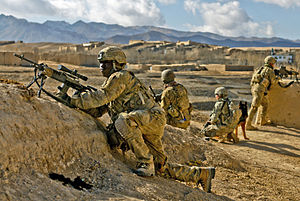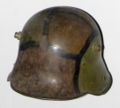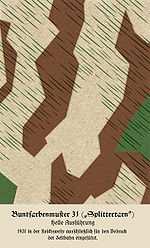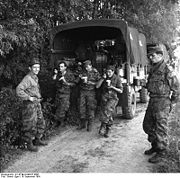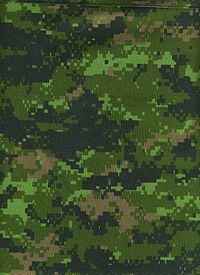- Military camouflage
-
See also: List of camouflage patterns
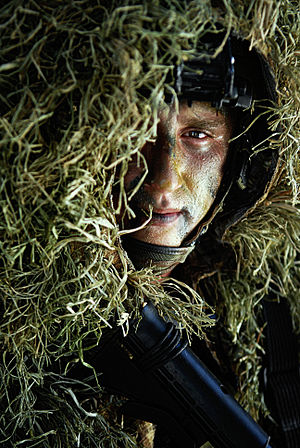 A camouflaged soldier of the Israel Defense Forces (IDF)
A camouflaged soldier of the Israel Defense Forces (IDF)
Military camouflage, an application of camouflage used on fatigues and military equipment, became an essential part of modern military tactics after the increase in accuracy and rate of fire of weapons during the 19th century. Until the 19th century armies tended to use bright colors and bold, impressive designs. These were considered to daunt the enemy, foster unit cohesion, allow easier identification of units in the fog of war, and attract recruits. In addition bright uniforms, such as the red coats formerly used by the British, tended to deter desertion.
The intent of camouflage is to disrupt an outline by merging it with the surroundings, making a target harder to spot or hit, or to confuse an observer as to its nature. Some modern camouflage, e.g. CADPAT, addresses visibility in the near infrared as well as visible light, for concealment from image intensification devices (night vision). Different countries have taken different paths towards the development of military camouflage.
Contents
History
United Kingdom
Main article: British Army uniformIn England, irregular units of gamekeepers in the 17th century were the first to adopt drab colours (common in the 16th century Irish units), following examples from the continent.[citation needed] A later example of camouflaged units would be the 95th Rifle Regiment and 60th Rifle Regiment, created during the Napoleonic Wars to strengthen the British skirmish line. As they carried more accurate Baker Rifles and engaged at a longer range, they were dressed in a rifle green jacket, in contrast to the Line regiments' scarlet tunics.[1] British forces during the mutiny of 1857 in India were dyeing their white drill uniforms to inconspicuous tone (following the practice started by the Corps of Guides in 1846), called khaki (from the Hindi-Urdu word for "dusty", itself a borrowed form of the Persian word "khak"[2], initially sometimes spelled "khakee" in English), by immersion in mud, tea, coffee or coloured inks. The resulting hue varied from dark or slate grey through light brown to off-white, or sometimes even lavender. This improvised measure gradually became widespread among the troops stationed in India and North-West Frontier, and sometimes among the troops campaigning on the African continent.[3] Khaki-coloured uniform became standard service dress for both British and British Indian Army troops stationed in British India in 1885, and in 1896 khaki drill uniform was adopted by British Army for the service outside of Europe in general,[4] but not until the Second Boer War, in 1902, did the entire British Army standardise on khaki (officially known as "drab") for Service Dress.[5]
The Lovat Scouts were formed from Scottish gamekeepers for service in the Boer war. They introduced the Ghillie suit for concealment for sniping in World War I.[6]
Other nations
The United States, who had green-jacketed rifle units in the Civil War, were quick to follow the British, going khaki in the same year. Russia followed, partially, in 1908. The Italian Army used grigio-verde ("grey-green") in the Alps from 1906 and across the army from 1909. The Germans adopted feldgrau ("field grey") in 1910. Portugal, during the Peninsular War, fielded light infantry known as Cacadores who wore brown-jackets which helped conceal them.
20th century wars
World War I
-
World War I Stahlhelm with camouflage pattern applied in the field
-
WWI soldiers in robes to make them appear as stumps and lichen to overhead aircraft[7]
-
Restored British 8 inch howitzer in typical WWI "dazzle camouflage" pattern
In Germany the traditional Prussian blue uniforms were replaced with Feldgrau ("fieldgrey") in 1910.[8] French uniforms in the early stage of the First World War consisted of bright red (garance) trousers and blue Greatcoats as part of the standard uniform.[9] An attempt to introduce a camouflage uniform in France in 1911 faced strong opposition as the red trousers were seen as a symbol of the French military doctrine. The former Minister of War Eugène Étienne stated:"Abolish red trousers? Never. France is red trousers."[10] The red French kepi hats were however soon covered with cloths[9][11] and the experiences of the modern warfare soon led to the introduction of a new uniform.[10] The Belgian Army started using khaki uniforms in 1915.
The development of camouflage drew on various skills and ideas of the period. An American artist and zoologist, Abbott Thayer published a book Concealing Coloration in the Animal Kingdom this book was widely read by military leaders in an attempt to understand how to camouflage military equipment and troops. Theories from Gestalt Psychology also influenced the development of camouflage as it deals with questions such as "How is it that we see a thing?". Contemporary artistic movements such as cubism, vorticism and impressionism also influenced the development of camouflage as they dealt with disrupting outlines, abstraction and colour theory.[12]
The French established a Section de Camouflage (Camouflage Department) in 1915, briefly headed by Eugene Corbin and then by Lucien-Victor Guirand de Scévola.[13] The experts were for the most part, painters, sculptors and theatre-set artists. Technological constraints meant patterned camouflage uniforms were not mass-produced during World War I. Each was hand-painted, and so they were restricted to snipers, forward artillery observers, and other exposed individuals. More effort was put into concealing equipment and structures. By mid-1915 the French section had four workshops (one in Paris and three nearer the front) mainly producing camouflage netting and painted canvas. Netting quickly moved from wire and fabric to raffia, burlap, and cocoa—natural materials were always recommended.
Other countries soon saw the advantage of camouflage and established their own units of Camoufleurs who were also artists, designers and architects. For example the United Kingdom (Camouflage Section established in late 1916 at Wimereux) and the U.S. (New York Camouflage Society, established in April 1917; official Company A, 40th Engineers, set up in January 1918; and the Women's Reserve Camouflage Corps) and to a lesser extent by Germany (from 1917, see, for example, lozenge camouflage covering Central Powers aircraft, possibly the earliest printed camouflage), Italy (Laboratorio di mascheramento, established in 1917), Belgium and Russia. The word camouflage entered the English language in 1917.[citation needed]
Camouflage added to helmets was unofficially popular, but these were not mass-produced until the Germans began in 1916 to issue Stahlhelm (steel helmets) in green, brown, or ochre.[citation needed] Mass-produced patterned, reversible, cloth covers were also issued shortly before the end of the war. Net covering was also examined, fitted with natural vegetation or with coloured fabric strips called scrim.
Specialist troops, notably snipers, could be supplied with items of camouflage, including patterned veils for the head and gun, hand-painted overalls and scrim-covered netting or sacking—an adaptation of the rag camouflage used in Scotland by anti-poaching wardens, gillies, the first ghillie suits.
Interwar period
The first mass-produced military camouflage was the Italian telo mimetico ("mimetic cloth") pattern of 1929, used to cover a shelter-half (telo tenda).
In 1931 it was copied and adopted by the German Army, who had begun using camouflaged cloth in 1918 with the indigenous Buntfarbenanstrich.
The Red Army issued "amoeba" disruptive-pattern suits to snipers from 1937 and all-white ZMK top-garments the following year, but it was not until hostilities began that more patterns were used.
World War II
With mass-production of patterned fabrics, camouflage uniforms became more common on individual soldiers in World War II. Initially, patterning was uncommon, a sign of elite units, to the extent that captured camouflage uniforms would be recycled by an enemy.
Finland
Finland has used snowsuits as winter camouflage for soldiers since its independence. At first, snow-camouflage suits were simple white overalls and they were easy and cheap to produce. When the Winter War began, Finnish forces were already issued with the appropriate camouflage while these were not available to Soviet forces.
USSR
The Red Army adopted brownish khaki-colored uniforms for most troops. Snow-camouflage coveralls were widely issued in the winter. Specialized units often wore one or two-piece hooded camouflage suits, such as long-range scouts, snipers and assault engineers. Initially, one-piece 'amoeba' pattern coveralls were worn over the standard khaki shirt and pants. The most common color schemes were a light ochre with dark brown blotches, and a light green with dark green blotches. Later, two-piece versions appeared in a variety of colors and patterns, some quite intricate. The sniper suits sometimes had ghillie-type attachments.
United Kingdom
Developed in the 1930s, khaki Battle Dress was issued widely from 1939. With the return of war, camouflage sections were revived. The British set up the Camouflage Development and Training Centre in 1940 at Farnham Castle, Surrey. Early staff included artists from the Industrial Camouflage Research Unit such as Roland Penrose and Frederick Gore, and the stage magician Jasper Maskelyne (later known for camouflage work in the North African campaign). The British did not use disruptive-pattern uniforms until 1942, with the hand-painted Denison smock for paratroopers, followed in 1943 with a similar style M42 garment.
United States
The U.S. Army Corps of Engineers began wide-ranging experiments in 1940, but little official notice was taken until 1942 when General Douglas MacArthur demanded 150,000 jungle camouflage uniforms. A 1940 design, "frog-skin", "leopard spot", or "duck hunter", was issued as a reversible beach/jungle coverall—soon changed to a two-part jacket and pants. It was first issued to the U.S. Marines fighting on the Solomon Islands and worn by Marine Raiders and Paramarine units as well as many regular Marine units in the Battle of Tarawa. Battlefield experience showed that pattern was unsuitable for moving troops, and production was halted in 1944 with a return to standard single-tone uniforms.
During 1944, units of the 2nd Armored Division in Normandy were issued with "frog skin"/"leopard spot" camouflage patterns, but similarity to the battledress worn by Waffen SS troops led to friendly fire and it was withdrawn.[14]
Full "leopard spot" uniforms continued to be worn by the USMC Amphibious Reconnaissance Battalion (whose role was reprised by the USMC Force Recon units from 1954) and by Combat Swimmer Reconnaissance Units (later to evolve into the Navy SEALs).
Germany
The Germans experimented before the war and some army units used "splinter" pattern camouflage. Waffen-SS combat units experimented from 1935. The initial, and much other, Waffen-SS camouflage was designed by Prof. Johann Georg Otto Schick.
- Platanenmuster—"plane-tree pattern" (1937–1942): spring/summer- and autumn/winter variations
- Rauchtarnmuster—"blurred edge" (1939–1944): spring/summer- and autumn/winter variations
- Palmenmuster—"palm pattern" (ca. 1941–?): summer/autumn variations
- Beringtes Eichenlaubmuster—"ringed oak leaf" (1942 bis 1945)
- Eichenlaubmuster—"oak leaf" (1943–1945): spring/summer- and autumn/winter variations
- Erbsenmuster—"pea pattern", or Pea-dot (1944–1945): spring/summer- and autumn/winter variations
- Leibermuster (1945)
- and also telo mimetico ("mimetic cloth"), using fabric seized from the Italians in 1943 (the Leibstandarte SS Adolf Hitler often wore this pattern).
The Sumpfmuster ("swamp pattern") is a Wehrmacht camouflage first introduced in 1943. A variation was introduced in 1944.
Apart from "Leibermuster", the official names of the wartime German camouflage patterns are not known: the names above are those used by military historians and collectors.
Postwar
France
Lizard pattern ( Leopard pattern for the French or TAP47) is a military camouflage used by the French Army on uniforms beginning in the 1950s up to the late 1980s. A Lizard pattern has two overlapping prints, generally green and brown, printed with gaps so that a third dyed color, such as a lighter green or khaki, makes up a large part of the pattern. In this, it is printed like earlier British patterns used on that country's paratroops' Denison smocks, and descends from those patterns. Lizard patterns have narrower printed areas than the British patterns, and strong horizontal orientation, cutting across the vertical form of a body. Other patterns descend in turn from Lizard patterns, either by imitation such as Cuba's Lizard pattern, or innovation, such as the tigerstripe patterns produced during the Vietnam War.
Germany
The first uniforms of the Bundeswehr in 1955 showed a camouflage similar to the pre-war Splittermuster.[citation needed] These were replaced by a plain dark green in the early 1960s, which was in turn replaced by the modern Flecktarn in 1990. It is the basis for Bundeswehr Wüstentarn, a desert camouflage.
East Germany's forces (Nationale Volksarmee (NVA) and the Ministerium des Inneren (MdI)) used the Flächentarnmuster between 1958 until it was replaced 1965 by the Strichtarnmuster camouflage.
United Kingdom
Battledress continued until the late 1950s. In the Korean War (1950–53), troops found the combat uniform inadequate: too hot in summer, and not warm enough in winter. Soldiers were at first issued Jungle Green (JG) uniforms for hot weather, and battledress in winter, but this had to be augmented with warm clothing, as well as caps with ear flaps and fur linings. A solution was pursued, and towards the end of the war a windproof and water-repellent gabardine combat uniform was issued. The trousers followed the battledress design, while the bush jacket had pockets inside and out, closing with zips and buttons, a hip-length skirt with draw-strings to keep out the wind, and a similar arrangement at the waist. The uniform was produced in greyish green (OG), similar to the U.S. Army Olive Drab (OD).
With the end of National Service in 1961, the Army looked for a new uniform: smarter than battledress, but also more comfortable, while still having a military air. Using Korean War clothing as a basis, new items were developed for the 1960-pattern Combat Dress, including the so-called Canadian pattern combat jacket, which was made with a lining above the waist and reinforced elbows. The 1960s was a transition for the Army, reflected in changes in uniform.
Disruptive Pattern
Main article: Disruptive Pattern MaterialThe new, smaller, all-volunteer Army could now afford to equip every soldier with his own camouflaged uniform, and a pattern, based on the brushstroke of the Denison Smock, was designed in 1960, called Disruptive Pattern (DP). The camouflage is more commonly known by the name given to the cloth printed with the pattern: Disruptive Pattern Material (DPM). By the late sixties it was issued in limited quantities on 1960-pattern jackets and trousers, making Britain the first country to issue regular troops with a standard camouflaged combat uniform. Known as ‘66-Pattern, it was superseded by the ’68-Pattern, which had a slightly revised design on a new uniform, featuring minor changes over the preceding 1960/66-Pattern kit, most notably: a full lining for jacket and trousers. DPM became official army-wide issue only in 1972.
Various redesigns since 1984 changed the size of the pattern and the tone of the colours, but DPM is easily recognisable and remains effective. Many countries use it or a variation.[12]
United States
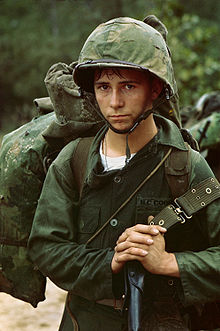 A U.S. Marine dressed in a "boonie suit" during the Vietnam War
A U.S. Marine dressed in a "boonie suit" during the Vietnam War
Many war surplus "leopard spot" uniforms were sold to allied nations reforming their armed forces. Worn by French parachutists in the First Indochina War, the "leopard spot" was marketed to civilian hunters under the name "duck hunter".
The CIA supplied "leopard spot" or “duck hunter” camouflage for Brigade 2506 Cuban exiles in the Bay of Pigs Invasion and South Vietnamese and Montagnard Civilian Irregular Defense Group (CIDG) counter-guerrillas until the pattern was replaced by the tigerstripe pattern in the mid-1960s. [Blechman H & Newman A, 2004].
During the Vietnam War, U.S. troops were issued a "boonie suit" in a single dull green for blending into the jungle. From the late 1950s the USMC had been issued with a variation on their World War II reversible helmet cover and shelter half. This had a tan and brown “brown clouds” side (printed with large identification numbers) and a green jungle side with a jagged “wine leaf” (a.k.a. “Mitchell”) pattern. Rangers and Special Forces units (aka Green Berets) adopted the Vietnamese "Tigerstripe" pattern with its distinctive horizontal slashes of black, green, and tan. Although this style became popular among the troops, it was not an official government issue uniform. It was procured by private purchase from civilian tailors. This is also called the "John Wayne pattern" as the design was featured in Wayne's 1968 film The Green Berets. Also in 1968, the brightly colored division shoulder patches worn since World War II were gradually replaced with a "subdued" green and black version. Name tags and other insignia patches soon followed.
U.S. Woodland pattern
Main article: Woodland (camouflage)Another, four color U.S. pattern, designed in 1948 by the Engineer Research & Development Laboratory (ERDL) based at Fort Belvoir, Virginia, was later revisited for use in the Vietnam War. Named ERDL Leaf pattern, it was first issued to elite reconnaissance and special operations units in early 1967.[12] It was initially produced in a lime dominant colourway, consisting of large organic shapes in mid green and brown, black ‘branches’, and light green ‘leaf highlights’. Shortly thereafter a brown dominant scheme (with the light green replaced by light tan) was manufactured. The two patterns are also known as ‘Lowland’ and ‘Highland’ ERDL respectively. The brown ‘Highland’ version was adopted as standard issue by the United States Marine Corps (USMC) from 1968, and later introduced on a wide scale in Southeast Asia by the U.S. Army, so that by the end of the Vietnam War American troops wearing camouflage combat dress had become the norm.[15] Following the withdrawal of the U.S. Army from the Southeast Asian Theatre in 1973, camouflage clothing was no longer routinely issued in that arm though the 1st Battalion 13th Infantry Regiment in Baumholder, Germany wore the Lowland ERDL in the early 1970s as an experiment. The USMC continued wearing a transitional ‘Delta’ ERDL pattern that was issued in the mid-1970s. It was not until 1981 that the U.S. Quartermaster Dept. approved another camouflaged uniform with the fielding, from September (not officially introduced until 1 October, however), of the battle dress uniform (BDU) in M81 Woodland pattern.[16] Although based on the Vietnam era brown dominant ERDL Leaf camouflage, but enlarged (by 60%),[17] and with the thicker black ‘shadows’ of the ‘Delta’ variant, the pattern was designed primarily for use in Europe. For the next two decades, this was the standard issue BDU for all arms of the U.S. military. Solid olive drab uniforms were rapidly phased out, such that by the time of Operation Urgent Fury in 1983, all participating units were clothed in M81 BDUs. The only exception being the Army Ranger Battalions who wore the olive drab uniforms until 1986.
U.S. Desert pattern
The formation of the Rapid Deployment Force (RDF) in 1979, with its remit to operate in the Middle East, and protect U.S. interests in the Persian Gulf region, saw the issue of the first U.S. desert camouflage clothing, a six colour Desert Battle Dress Uniform (DBDU), that had been originally designed in 1962. With a base pattern of light tan overlaid with broad swathes of pale olive green and wide two-tone bands of brown, the clusters of white-on-black spots scattered over it resulted in it being nicknamed the "chocolate chip" pattern. It was worn by U.S. troops taking part in the biennial Bright Star exercises in Egypt during the 1980s, and by FORSCOM peacekeepers in the Egyptian Sinai. Feedback from these users indicated that the design contrasted too much with the terrain. Anecdotal evidence suggested that the dark areas of the pattern warmed up more than the paler parts under desert sunlight, and retained the heat longer. The six colours were also more expensive to manufacture than three or four colours, and so the U.S. Army Natick Soldier Center began the search for a substitute. Samples of sand and earth from the Middle East were measured for optical and infrared reflectance, and seven trial patterns were created using these statistics. The patterns were evaluated in fourteen different desert locations and narrowed down to one favourite. The resulting "Desert Camouflage Pattern: Combat" was standardized in 1990, but was not ready before troops deployed to Saudi Arabia during the Gulf War of 1990-1991. Consequently U.S. forces wore the six colour DBDUs during the campaign. An initial batch of desert BDUs in the new scheme was enroute to the Middle East when hostilities ceased.[12] The pattern, officially issued with the new Desert Camouflage Uniform (DCU) in 1993, consisted of a subtle blend of large pastel green and light tan shapes, with sparsely placed, narrow, reddish brown patches, leading the design to be unofficially nicknamed the “Coffee Stain” pattern. This remained in service for over a decade, most notably during the 2003 invasion of Iraq. Currently this pattern is being replaced by various digital pixel patterns.
Digital
Digital camouflage (or "digicam") is a pattern devised by using small micropatterns, as opposed to larger macropatterns for effective disruption. The theory is that large blotches of color with sharp outlines are easier to see, while "blurring" the edges of the colored patches makes the outlines, and thus the objects, harder to discern. The name is referring to the coordinates of the pattern, which are digitally defined, as well as the set of colors used. Most non-digital camouflage patterns, although also consisting of a digital color set, do not use digital coordinates. From 1978 to the early 1980s, the American 2nd Armored Cavalry Regiment stationed in Europe used a digital camouflage pattern (dual-tex) on its vehicles. During 1979 and 1980, the Australian Army experimented with digital camouflage (dual-tex) on helicopters.[citation needed]
More recently, battledress in digital camouflage patterns has been adopted by the Canadian Forces (who pioneered the design), which bears similarities to the Bundeswehr's (Flecktarn), the United States Marine Corps (MARPAT), the military of Jordan (KA2 series), United States Army (Universal Camouflage Pattern), the United States Air Force (Airman Battle Uniform), the Philippine National Police Special Action Force, the Philippine Marine Corps, the Philippine Army, the National Army of Colombia (Patriota), the Ecuadorian Army, the Peruvian Army (PACIPAT), the Guatemalan Army Special Operations Brigade, the Italian Army (Vegetato), Estonian Defence Forces (ESTDCU), the Iraqi National Police, the Croatian Army, the Military of Latvia (NBS2006), the Finnish Defence Forces (M05), China Armed Police Force (Type 05) and Chinese People's Liberation Army (Type 07), the Turkish Armed Forces (UCP like has 7 colors), Serbian Army and Police (M-10) and (DMDU-03), Kuwaiti Army (KAPAT), Russian Federation Army (SURPAT, Pixel Flora, and KSOR Digital), Royal Thai Armed Forces, the Indonesian Army Batalyon Raiders, Mexican Armed Forces (SEDENA-08 Types A, B C, and D), the Lebanese Airborne Regiment and the Lebanese Navy SEALs Regiment, Singapore Armed Forces (woodland and arid), and the Yemeni Internal Security Forces.[citation needed] The South Korean Army possibly around August 2006, already adopted a digital camouflage pattern that is somewhat similar to the USMC's MARPAT—it is currently being supplied to Special Warfare Command units. Meanwhile, they are going to introduce another digital camo scheme for regular units very soon. The German, Danish, and Japanese military today use camouflage that involves dots (flecktarn) instead of pixelated patterns. Presently, the digital camouflage for personal clothing is being actively evaluated by some other countries, e.g. Austria, Poland, and Spain.[citation needed]
Digital camouflage in desert colors is used by Kuwaiti army forces, replacing older camo patterns in 2007. Jordan adopted a very similar design in 2008 as well.
This camo pattern repeats in stagger serial fashion, which helps to lead the eye away from outlines.[18]
Vehicles
Land vehicles
 An M901 with MERDC winter verdant camouflage scheme.
An M901 with MERDC winter verdant camouflage scheme.
The purpose of vehicle and equipment camouflage differs from personal camouflage in that the primary threat is aerial reconnaissance. The goal is to disrupt the characteristic shape of the vehicle, reduce shine, and make the vehicle difficult to identify even if it is spotted.
Paint is the least effective measure, but forms a basis for other techniques. Military vehicles often become so dirty that pattern-painted camouflage is not visible and although matte colours are used to reduce shine, a wet vehicle can still be very shiny, especially when viewed from above. Patterns are designed to make it more difficult to interpret shadows and shapes. The British Army adopted a disruptive scheme for their vehicles operating in the stony desert of the North African Campaign and also Greece, retrospectively known as the "Caunter scheme". This used up to six colours applied with straight lines.
Nets can be highly effective at defeating visual observation. Traditional camouflage nets use a textile ‘garnish’ to generate an apparent texture with a depth of shadow created beneath it. Modern nets tend to be made of a continuous woven material, which is easier to deploy over a vehicle and doesn’t have “windows” between the patches of garnish of traditional nets. Nets are occasionally fixed in place around gun tubes or turrets, and if adequately attached can remain in place while the tank is moving. Nets are far less effective in defeating radar and thermal sensors. Heavier, more durable mobile camouflage systems, have been developed to bridge the technology gap between paint and nets. Essentially they are a conformal duvet which can include materials with thermal and radar properties.
Natural materials, such as tree branches, bundles of leaves, piles of hay or small bits of urban wreckage can be highly effective when the vehicle is in a defensive position.
Ship
Main article: Ship camouflageUntil the 20th century, naval weapons had a very short range, so camouflage was unimportant for ships or the men on board them. Paint schemes were selected on the basis of ease of maintenance or aesthetics, typically buff upperworks (with polished brass fittings) and white or black hulls. At the turn of the century the increasing range of naval engagements, as demonstrated by the Battle of Tsushima, prompted the introduction of the first camouflage, in the form of some solid shade of gray overall, in the hope that ships would fade into the mist.[citation needed] Another set of paint patterns was used not to make ships disappear, but to make them seem smaller and/or faster, to encourage misidentification by an enemy and to make the ships harder to hit.[19]
After the Second World War, the universal adoption of radar made camouflage generally less effective. However, camouflage might have helped United States warships avoid hits from Vietnamese shore batteries using optical rangefinders.[20]
Aircraft
Main article: Aircraft camouflage A Ukrainian Su-25 painted with earth colors on the top and sky color on the bottom
A Ukrainian Su-25 painted with earth colors on the top and sky color on the bottom
The design of camouflage for aircraft is complicated by the fact that the appearance of the aircraft's background varies widely depending on the location of the observer (above or below) and the nature of the background. Many aircraft camouflage schemes of the past used countershading, where a light color was used underneath and darker colors above.
Other camouflage schemes acknowledge that the aircraft will be twisting and turning while in combat, and the camouflage pattern is applied to the entire aircraft. Neutral and dull colors are preferred, and two or three shades selected, depending on the size of the aircraft. Though air-to-air combat is often initiated outside of visual range, at medium distances camouflage can make an enemy pilot hesitate until certain of the altitude, distance and maneuver of the camouflaged aircraft.
The higher speeds of modern aircraft, and the reliance on radar and missiles in air combat have reduced the value of visual camouflage, while increasing the value of electronic "stealth" measures. Modern paint is designed to absorb electromagnetic radiation used by radar, reducing the signature of the aircraft, and to limit the emission of infrared light used by heat seeking missiles to detect their target. Further advances in aircraft camouflage are being investigated in the field of active camouflage.
In fashion and art
The transfer of camouflage patterns from battle to exclusively civilian uses is not a recent phenomenon. The first military camouflage was used by the French on their trucks and automobiles (the only military vehicles of the day) and within three weeks of the German invasion of France in 1914, the couturiers of Paris, having observed them, had turned those abstract patterns into women's clothing. It symbolized modernity to them, the first industrial war. Ironically, this means that it was used for civilian clothing long before it was used for uniforms. Dazzle camouflage also inspired a trend of dazzlesque patterns used on clothing in England, in 1919 Chelsea Arts Club held a "Dazzle Ball", those attending wore disruptively patterned black and white clothing. The earliest camouflage artists were members of the Post- Impressionist and Fauve schools of France. The camouflage experts were, for the most part, painters like Forain, Camoin, Villon and Marcoussis, sculptors like Boucher and Despiau, and theatre set artists [5]. Camouflage schemes of the First World War and Interwar periods that employed disruptive patterns were often described as "cubist" by commentators, and Picasso is even said to have claimed "We invented that (camouflage)". Despite this, there is little evidence that the cubists themselves were employed as camoufleurs.
While many hundreds of artists were involved in the development of camouflage during and since World War I, the disparate sympathies of the two cultures restrained the use of "militaristic" forms in works other than those of war artists. Since the 1960s, however, artists have seized upon camouflage as a means to twist and subvert it away from its military origins and symbolism. The concept of camouflage - to conceal and distort shapes - is also a popular artistic tool.
Artists using camouflage include:
- Andy Warhol (notably his 1986 camouflage series, his last major work, including Camouflage Self-Portrait)
- Alain Jacquet (extraordinarily prolific in camouflage works from 1961 into the 1970s)
- Ian Hamilton Finlay, Vera von Lehndorff (aka Veruschka) and Holger Trülzsch ("Nature, Signs & Animals", "Mimicry-Dress-Art", all 1970-73)
- Thomas Hirschhorn (Utopia : One World, One War, One Army, One Dress, 2005).
Marine sniper in a ghillie suit, adapted from hunting garb.
Camouflage garments had a similarly hesitant adoption, although military styling has a long history of civilian use. Military patterns initially found civilian markets amongst hunters and, through military surplus, in those seeking clothing that was tough, well-made, and cheap in the United States and other countries. The steady output from countries using a national service model was influential, and several countries (initially the 'winning' sides of World War II, where there was less negative connection with military-wear) became significant markets. In the United States in the 1960s, military clothing became increasingly common (mostly olive drab rather than patterned camouflage); interestingly, it was often found worn by anti-war protestors, initially within groups such as Vietnam Veterans Against the War but then increasingly widely as a symbol of political protest. In the years after the Vietnam War, camouflage military clothing became very popular among many people, replacing olive-drab military clothing. Today, modern military camouflage clothing is popular with outdoors enthusiasts like hunters and people who engage in paintball, airsoft, and outdoor laser skirmish games.
The "rebellious" links of civilian camouflage diminished through the 1970s and beyond as more mainstream groups adopted a style seen as youthful and anti-establishment. Fashion has since become increasingly eager to adopt camouflage - attracted by the striking designs, the "patterned disorder" of camouflage, its symbolism (to be celebrated or subverted [vide its use by Hello Kitty]), and its versatility. Early designers include Jean-Charles de Castelbajac (1975-), Roland Chakal (1970), Stephen Sprouse (using Warhol prints, 1987–1988), and Franco Moschino (1986), but it was not until the 1990s that camouflage became a significant and widespread facet of dress from streetwear to high-fashion labels - especially the use of "faux-camouflage". Producers using camouflage in the 1990s and beyond include: John Galliano for Christian Dior, Marc Jacobs for Louis Vuitton, Comme des Garçons, Chanel, Tommy Hilfiger, Dolce & Gabbana, Issey Miyake, Armani, Yves Saint-Laurent, and others.
Certain companies have become very closely associated with camouflage patterns (such as Maharishi and mhi, Zoo York, Addict, 6876, A Bathing Ape, Stone Island, and Girbaud), using and overprinting genuine military surplus fabric, and have also extended the patterns by creating their own designs or integrating camouflage patterns with other symbols. The use of original patterns in new (often bright) colors is also common.
Some countries such as Barbados, Aruba, and other Caribbean nations have strict laws that prohibit camouflage clothing from being worn by non-military personnel, including tourists and children.[12] These laws may be motivated by the fear that a tourist might be mistaken by government troops for insurgents, or vice versa, and fired upon.[citation needed]
References
- ^ Haythornthwaite P.,: British Rifleman 1795-1815, Osprey Publishing, 2002, p.20
- ^ Oxford Dictionary. [1]
- ^ Barthorp, Michael (1988). The British Army on Campaign 1816-1902: Volume 3 (1856-1881). Osprey Publishing. pp. 24–37. ISBN 0-85045-835-8.
- ^ Barthorp, Michael (1988). The British Army on Campaign 1816-1902: Volume 4 (1882-1902). Osprey Publishing. pp. 24–33. ISBN 0-85045-849-8.
- ^ Chappell, M.: The British Army in World War I (1), Osprey, 2003, p.37
- ^ Pegler, M: The Military Sniper Since 1914, Osprey, 2001, p.18
- ^ Not Monks, But Camouflaged Artillerymen, Popular Science monthly, Sep 1918, page 335, Scanned by Google Books: http://books.google.com/books?id=yiQDAAAAMBAJ&pg=PA335
- ^ Showalter, Dennis E. (2004). Tannenberg:clash of empires 1914. p. 148. ISBN 1-57488-781-5. http://books.google.de/books?id=mdIiDEPlKnYC&pg=PA148&dq=feldgrau+1910&hl=de&ei=V-mnTfChN5CVswaqzKH_Bg&sa=X&oi=book_result&ct=result&resnum=4&ved=0CDwQ6AEwAzgU#v=onepage&q=feldgrau%201910&f=false.
- ^ a b First World War - Willmott, H.P., Dorling Kindersley, 2003, Page 53
- ^ a b Crowdy, Terry (2007). Military Misdemeanors. p. 149. ISBN 978-1-84603-148-9. http://books.google.de/books?id=8-Q1B0F3OiwC&pg=PA148&dq=feldgrau+1910&hl=de&ei=BPCnTe24E9HDswbq8ciDBw&sa=X&oi=book_result&ct=result&resnum=1&ved=0CCwQ6AEwADgU#v=onepage&q=feldgrau%201910&f=false.
- ^ First World War - Willmott, H.P., Dorling Kindersley, 2003, Page 59
- ^ a b c d e Blechman/Newman, Hardy/Alex (2004). DPM: Disruptive Pattern Material. Department of Publications, Maharishi. ISBN 0-9543404-0-X.
- ^ Tate ETC - Art Culture and Camouflage
- ^ [2]
- ^ Newark (2007). Camouflage. Thames & Hudson. ISBN 978-0-500-51347-7.
- ^ "Support Equipment". Department of the Army Historical Summary FY 1981. United States Army Center of Military History. 1981. http://www.history.army.mil/books/DAHSUM/1981/ch07.htm.
- ^ [3]
- ^ Turner, Martin; Jonathan M. Blackledge, Patrick R. Andrews (1998). Fractal geometry in digital imaging. Academic Press. ISBN 0127039708.
- '^ See discussion of the Bismarcks camouflage at [4].
- ^ Sumrall, Robert F. "Ship Camouflage (WWII): Deceptive Art" United States Naval Institute Proceedings February 1973 pp.67-81
Further reading
- Blechman, Hardy and Newman, Alex (2004). DPM: Disruptive Pattern Material. DPM Ltd. ISBN 0-9543404-0-X.
- Behrens, Roy R. (2002). False Colors: Art, Design and Modern Camouflage. Bobolink Books. ISBN 0-9713244-0-9.
- Behrens, Roy R. (2009). Camoupedia: A Compendium of Research on Art, Architecture and Camouflage. Bobolink Books. ISBN 978-0-9713244-6-6.
- Everdell, William R. (1997). The First Moderns. University of Chicago Press.
- Goodden, Henrietta (2007). Camouflage and Art: Design for Deception in World War 2. Unicorn Press. ISBN 0906290872.
- Hartcup, Guy (2008). Camouflage: The History of Concealment and Deception in War. Pen and Sword. ISBN 1844157695.
- Newark, Tim (2007). Camouflage. Thames & Hudson.
- Williams, David (2001). Naval camouflage, 1914-1945 : a complete visual reference. Naval Institute Press. ISBN 1-55750-496-2.
External links
- "Abbott Thayer's Camouflage Demonstrations: Countershading, Disruption and Background Picturing"
- Shipcamouflage.com
- Roy R. Behrens - Art and Camouflage: An Annotated Bibliography
- U.S. Army manual FM 21-76 on camouflage
- Guy Hartcup - Camouflage: A History of Concealment and Deception in War (1980)
- WWII War Department Field Manual FM 5-20B: Camouflage of Vehicles (1944)
- Over 70 different Camo-Patterns in direct Comparison
- Camouflage Paint Colours
Categories:- Military camouflage
- Camouflage patterns
- Sniper warfare tactics
-
Wikimedia Foundation. 2010.

